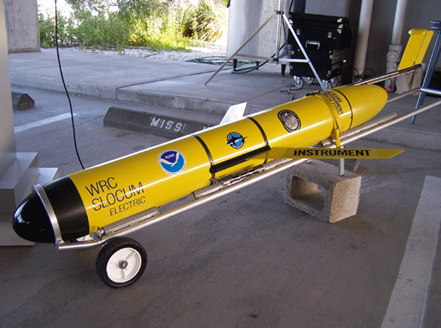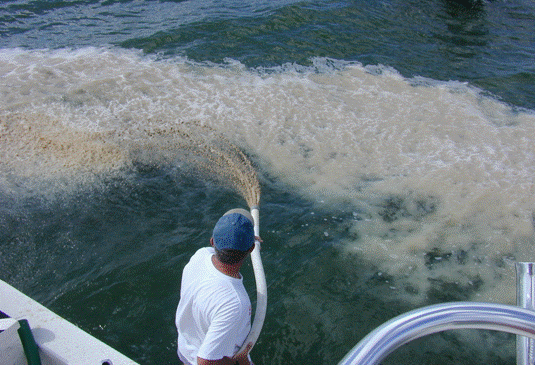
CSCOR HAB program accomplishments include not only tools and technologies that advance management capabilities but also scientific discoveries that improve management approaches, dissemination of knowledge (e.g. through workshops, public outreach) that facilitates coordination, and contributions to core infrastructure needs that supports research and management . Below are a few recent examples of important research advances supported by CSCOR HAB programs.
Forecasting and Early Warning
First Annual Gulf of Maine HAB Prediction
Blooms of the saxitoxin-producing algae, Alexandrium, are a recurrent problem in the Gulf of Maine. Shellfish harvesting closures to protect humans from paralytic shellfish poisoning (PSP) have occurred every year for the past three decades. In 2008, CSCOR-supported researchers made the first-ever prediction of the size and extent of the Alexandrium bloom, or “New England red tide”, based on a model developed through 10 years of ECOHAB and MERHAB funding. The annual prediction along with weekly forecasts of bloom movement allow shellfish managers to focus sampling and make more precise closures to minimize economic impacts while protecting human health. For more information, click here.
Gulf of Mexico HAB Bulletin
NOAA's HAB Forecasting System in the Gulf of Mexico integrates satellite imagery, field observations, and buoy data to provide information on the location, extent, and potential for development or movement of harmful algal blooms in the Gulf of Mexico. The NOAA HAB Bulletin is distributed twice weekly to the management community, allowing early warnings to limit public exposure and to more effectively target sampling. The Bulletin is a collaborative effort of NOAA Center for Coastal Monitoring and Assessment, NOAA CoastWatch, and NOAA Coastal Services Center and is operational in NOAA's Center for Operational Oceanographic Products and Services (CO-OPS). In addition, several years of research supported by the ECOHAB Program helped to develop this HAB forecasting system and have produced an in-water sensor that can detect the Florida red tides and is used as a supplemental source of data. The MERHAB Program has supported the State of Florida to collect monitoring data used to ground truth the operational HAB Bulletin in Florida. MERHAB has also sponsored efforts to adapt and expand the HAB Bulletin into Texas waters.
ORHAB Partnership Yields Effective Early Warning of Shellfish Toxicity
Domoic acid-producing Pseudo-nitzchia blooms are a recurrent problem along the entire Pacific coast of the United States. The toxin, domoic acid, can accumulate in shellfish and cause amnesic shellfish poisoning (ASP) in human consumers. The Olympic Region Harmful Algal Bloom (ORHAB) partnership was formed through MERHAB support and involves Federal, state, and local management agencies, coastal Indian tribes, marine resource-based businesses, public interest groups, and academic institutions. The ORHAB partnership ultimately developed and adopted a combination of techniques to provide managers an effective early warning of domoic acid toxicity in shellfish. The forecasts generated by ORHAB are now sustained through state funding and have increased the commercial, subsistence, and recreational harvest of razor clams while minimizing the health risks to consumers.
Cell and Toxin Detection
New molecular-based assays have been developed for a number of HAB species and are used routinely for HAB detection in several regions of the country. Additionally, an instrument was developed that optically detects the Florida Red Tide organism in the water and can be deployed on underwater vehicles and moorings providing higher temporal resolution than monitoring by other means.

A new test was developed for detecting neurotoxic shellfish poisoning (NSP) toxins produced by the Florida Red Tide organism, Karenia. The test is more sensitive and efficient than the traditional mouse bioassay and is being considered for regulatory use. Additionally, a quick and easy test for detecting domoic acid (the toxin that causes ASP) in the field was developed through collaborative efforts of NOAA MERHAB, NOAA CCFHR, NOAA NWFSC, and the Quileute Indian tribe.
Control
Testing Clay as a Control for Blooms
Clay was first used in Korea to effectively and cheaply remove HAB cells that threaten finfish mariculture. The principal behind cell removal is that as the small particles collide they form rapidly-sinking aggregates (or flocs) that settle to the sea bottom. In the U.S., NOAA CSCOR-funded researchers have tested phosphatic clays and other flocculating agents for environmental safety and effectiveness in removing a variety of HABs. Tests have grown from small flasks, to enclosed containers in the field, to field pilot studies. Clays have been found to be effective in controlling blooms of fish-killing species that occur in the Gulf of Mexico and Pacific Northwest, but additional risk-benefit analysis is required before routine use.

HAB Event Response
Successful multi-agency event response assisted states with monitoring and early warning during large Alexandrium blooms in 2005, 2006, and 2008. For examples of how CSCOR HAB Event Response has helped managers in other parts of the country, click here.